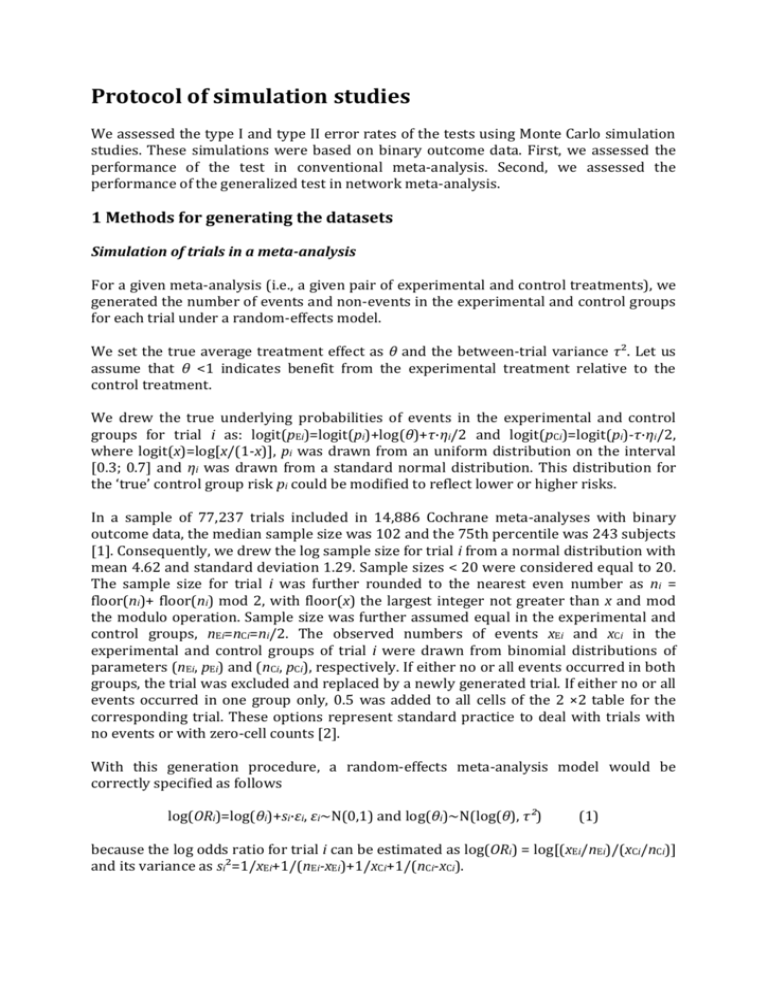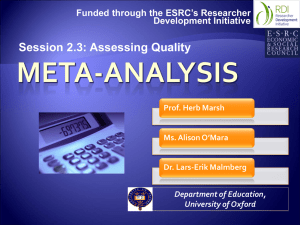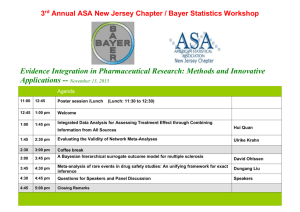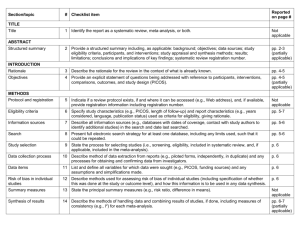1471-2288-14-112-S1
advertisement

Protocol of simulation studies
We assessed the type I and type II error rates of the tests using Monte Carlo simulation
studies. These simulations were based on binary outcome data. First, we assessed the
performance of the test in conventional meta-analysis. Second, we assessed the
performance of the generalized test in network meta-analysis.
1 Methods for generating the datasets
Simulation of trials in a meta-analysis
For a given meta-analysis (i.e., a given pair of experimental and control treatments), we
generated the number of events and non-events in the experimental and control groups
for each trial under a random-effects model.
We set the true average treatment effect as θ and the between-trial variance τ². Let us
assume that θ <1 indicates benefit from the experimental treatment relative to the
control treatment.
We drew the true underlying probabilities of events in the experimental and control
groups for trial i as: logit(pEi)=logit(pi)+log(θ)+τ·ηi/2 and logit(pCi)=logit(pi)-τ·ηi/2,
where logit(x)=log[x/(1-x)], pi was drawn from an uniform distribution on the interval
[0.3; 0.7] and ηi was drawn from a standard normal distribution. This distribution for
the ‘true’ control group risk pi could be modified to reflect lower or higher risks.
In a sample of 77,237 trials included in 14,886 Cochrane meta-analyses with binary
outcome data, the median sample size was 102 and the 75th percentile was 243 subjects
[1]. Consequently, we drew the log sample size for trial i from a normal distribution with
mean 4.62 and standard deviation 1.29. Sample sizes < 20 were considered equal to 20.
The sample size for trial i was further rounded to the nearest even number as ni =
floor(ni)+ floor(ni) mod 2, with floor(x) the largest integer not greater than x and mod
the modulo operation. Sample size was further assumed equal in the experimental and
control groups, nEi=nCi=ni/2. The observed numbers of events xEi and xCi in the
experimental and control groups of trial i were drawn from binomial distributions of
parameters (nEi, pEi) and (nCi, pCi), respectively. If either no or all events occurred in both
groups, the trial was excluded and replaced by a newly generated trial. If either no or all
events occurred in one group only, 0.5 was added to all cells of the 2 ×2 table for the
corresponding trial. These options represent standard practice to deal with trials with
no events or with zero-cell counts [2].
With this generation procedure, a random-effects meta-analysis model would be
correctly specified as follows
log(ORi)=log(θi)+si·εi, εi~N(0,1) and log(θi)~N(log(θ), τ²)
(1)
because the log odds ratio for trial i can be estimated as log(ORi) = log[(xEi/nEi)/(xCi/nCi)]
and its variance as si²=1/xEi+1/(nEi-xEi)+1/xCi+1/(nCi-xCi).
Simulation of reporting bias in a meta-analysis
We used 2 selection models to simulate reporting bias affecting trials in a meta-analysis.
The first one links the probability of trial selection to both trial size and intensity of
treatment effect [3-5]. The second one selects trials depending on the p-value for
treatment effect associated with the trial [6-8].
Model of selection of trials by trial size and treatment effect magnitude
We considered that model (1) would describe all existing trials but only some of them
are selected in the meta-analysis with propensity
zi=a+b/si+δi with δi~N(0,1)
(2)
Only trials with positive values of zi are selected in the meta-analysis. Models (1) and (2)
are combined as
log(ORi)=log(θi)+σi·εi, εi~N(0,1) with log(θi)~N(log(θ), τ²), zi=a+b/si+δi, δi~N(0,1)
and by assuming that the residuals (εi, δi) follow a bivariate normal distribution with
both means 0, both variances 1 and correlation ρ. The standard deviation σi of log(ORi)
now differs from si which is an estimate of the conditional variance of log(ORi) given that
2 1
1
1
1
trial i was selected; σi was estimated by n (p + 1-p + p + 1-p ). If ρ = 0, the selection is
i
Ei
Ei
Ci
Ci
independent from the observed outcome; because we assumed that log(θ)<0 indicates
benefit from the experimental treatment, when ρ is negative and large, selected trials
have zi > 0 and are more likely to have positive δi, thus negative εi and log(ORi)
underestimating log(θ), thereby showing larger benefit.
Under this model, the probability for trial i to be selected is shown as 𝑝̃𝑖 =
𝛷 ([𝑢𝑖 + 𝜌̃𝑖 ((log(𝑂𝑅𝑖 ) − log(𝜃))⁄√𝜏 2 + 𝜎𝑖2 )]⁄√1 − 𝜌̃𝑖2 ) where ui= a+b/si, and 𝜌̃𝑖 =
𝜎𝑖 ∙ 𝜌⁄√𝜏 2 + 𝜎𝑖2 .
We set (a, b) by setting arbitrary values for the selection probabilities for a smaller trial
and a larger trial: P(trial i selected | si=0.4)=0.1 and P(trial i selected | si=0.05)=0.9,
which gives a=-1.65 and b=0.16. Several values for ρ were considered (−0.6,−0.8,−1.0).
Given log(ORi) and si, it allows for estimating 𝑝̃𝑖 . We drew a Bernoulli variable
distributed with probability 𝑝̃𝑖 . If the generated value is 1, the trial is selected; otherwise
the trial is excluded and replaced with a newly generated trial.
Model of selection of trials by treatment effect p-value
We also used another class of explicit selection models proposed so far for meta-analysis
to model reporting bias [9-11]. The standard formulation of this selection model is that
the probability density function of the observed treatment effect 𝑦𝑖 = log(𝑂𝑅𝑖 ) is a
weighted density of the treatment effect before selection: 𝑓(𝑦𝑖 |trial𝑖selected, 𝑠𝑖 ) =
∞
𝑓(𝑦𝑖 |𝑠𝑖 ) ∙ 𝑃(trial𝑖selected|𝑦𝑖 , 𝑠𝑖 )⁄∫−∞ 𝑓(𝑦𝑖 |𝑠𝑖 ) ∙ 𝑃(trial𝑖selected|𝑦𝑖 , 𝑠𝑖 )𝑑𝑦𝑖 ,
where
𝑓(𝑦𝑖 |𝑠𝑖 ) is the density function of the treatment effect before selection (a normal
distribution). If the weight function 𝑃(trial𝑖selected|𝑦𝑖 , 𝑠𝑖 ) is not a constant, the
distribution of the observed treatment effect differs from that of the unselected
treatment effect, and this difference corresponds to reporting bias. More specifically, we
considered that only some trials are selected in the meta-analysis according to a known
𝛾
weight function 𝑃(trial𝑖selected|𝑦𝑖 , 𝑠𝑖 ) = 𝑤(𝑝𝑖 ) = exp(−𝛾0 𝑝𝑖 1 ) with pi the p-value
associated with a two-sided Fisher’s exact test for a difference in the proportion of
events between the experimental and control groups of trial i. Because w(pi) is a nonincreasing function of the p-value, trials with smaller p-values are more likely to be
selected than are those with larger p-values. Several values for (𝛾0, 𝛾1) were considered
(𝛾0=4 and 𝛾1= 3, 3/2 or 3/4). Because we set 𝛾0 and 𝛾1, it allowed for estimating w(pi).
For each trial, we drew a Bernoulli variable distributed with probability w(pi). If the
generated value was 1, the trial is selected, otherwise the trial is excluded and replaced
with a newly generated trial.
Simulation of a network of trials
We simulated a network of trials as J meta-analyses of nj=n trials each. For each metaanalysis j, we set the true average treatment effect θj. We considered that the J true
average treatment effects would be centered on a log odds ratio of ψ1 =log(0.75) or ψ2
=log(0.95). We further considered that the dispersion of the true average treatment
effects across the J meta-analyses could be smaller or larger, with variance on the log
scale of ν1=0.02 and ν2=0.08, respectively. In all, 95% of true average odds ratios across
the J meta-analyses would be within a factor of exp(1.96×√ν) of ψ. This equates to
factors of 1.32 and 1.74 when the variance is ν1 and ν2, respectively. Consequently, we
considered 4 distinct scenarios by setting known relative effects from log(θj)~N(ψ, ν)
with ψ = ψ1 or ψ2 and ν = ν1 or ν2. The sets of realizations are reported in Table 1. We
further assumed homogeneity of between-trial variation within the J meta-analyses, i.e.,
τj²= τ². For a given meta-analysis, data were then generated as described.
Simulation of reporting bias in a network of trials
Reporting bias was induced for each of the J meta-analyses constituting the network as
described, under the assumption that the propensity for bias would be similar across the
J meta-analyses. When selecting trials according to trial size and treatment effect
magnitude, we drew each ρj from an uniform distribution over the support [ρmin;ρmax].
When selecting trials according to treatment effect p-value, we drew each 𝛾1𝑗 from a
uniform distribution over the support [𝛾1𝑚𝑖𝑛 ;𝛾1𝑚𝑎𝑥 ]. Several values were considered for
(ρmin, ρmax) and (𝛾1𝑚𝑖𝑛 , 𝛾1𝑚𝑎𝑥 ) and are thus given below in the section describing the
various scenarios.
2 Scenarios to be investigated
In a sample of 77,237 trials included in 14,886 Cochrane meta-analyses with binary
outcome data, the median number of trials in a meta-analysis was 3 (75% percentile 6,
90% percentile 10 and 99% percentile 28) [1]. From the same sample of meta-analyses,
the predictive distribution for between-trial heterogeneity in a future meta-analysis in a
general setting was estimated as lognormal (-2.56,1.74) for median 0.08 and 25%-75%
percentiles 0.02-0.25 on the untransformed scale [12]. Consequently, we considered the
following scenarios.
To simulate a meta-analysis, we chose n as the number of trials, the true average
treatment effect θ and between-trial variance τ². We used n as (6, 10, 30); θ as (0.5, 0.75,
1.0); τ² as (0.02, 0.08, 0.25). When we induced reporting bias, we simulated data until n
trials had been selected with ρ as (−0.6,−0.8,−1.0) or with 𝛾0=4 and 𝛾1as (3, 3/2, 3/4).
These values correspond to different extents of bias from moderate to severe.
To simulate a network of trials, we chose J as the number of meta-analyses constituting
the network, nj=n the number of trials in each meta-analysis, the true average treatment
effects θj and the between-trial variation τ². We took J as (6, 10), n as (3,6), θj as in Table
1, and τ² as (0.02, 0.08, 0.25). When we induced reporting bias, we simulated data until n
trials had been selected with each ρj~Uniform[−0.8;−0.6] or ρj~Uniform[−1.0;−0.8] or
with 𝛾0𝑗 =4 and 𝛾1𝑗 ~Uniform[3/2;3] or 𝛾1𝑗 ~Uniform[3/4;3/2] to reflect similar
moderate and severe bias, respectively, across the J meta-analyses.
3 Criteria to evaluate the performance of the test
We assessed the performance of the tests in a conventional meta-analysis and in a
network meta-analysis. We assessed its empirical type I error rate and power (1- type II
error rate) for scenarios without and with reporting bias, respectively. Each test statistic
was simulated B times under the null hypothesis and B times under the alternative. For a
network
meta-analysis,
the
estimated
type
I
error
rate
is
𝛼̂ =
̂=
⁄
𝐵 −1 #{∑𝑁
𝑏(𝑖|𝑁,
𝐸
𝑁
)
<
0.10|noreportingbias}
and
the
estimated
power
is
1
−
𝛽
𝑖=𝑂
𝑁
−1
𝐵 #{∑𝑖=𝑂 𝑏(𝑖|𝑁, 𝐸 ⁄𝑁) < 0.10|reportingbias}.
Because the estimated type I error rate can differ from the nominal type I error level, we
took into account the possibly differing type I error rates of the tests and we estimated
powers adjusted for type I error rate by a probit analysis [13]. Moreover, we estimated
the likelihood ratio of a positive test result as the ratio of the (unadjusted) power to the
type I error rate (1 − 𝛽̂ )⁄𝛼̂. This reflects the likelihood that a significant test result is
found in networks with bias as opposed to networks without bias. We also estimated the
likelihood ratio of a negative test result as the ratio of the (unadjusted) type II error rate
to 1 minus the type I error rate 𝛽̂ ⁄(1 − 𝛼̂). This reflects the likelihood that a nonsignificant test result is found in networks with bias as opposed to networks without
bias.
In the cases of a conventional meta-analysis, we also assessed for comparison purposes
the performance of the test introduced by Rucker et al. based on a weighted regression
of the arcsine transformation of observed risks with explicit modeling of between-trial
heterogeneity [5].
4 Number of simulations to be performed
To obtain a confidence interval, with confidence level 1-α, for proportion p with prespecified accuracy A, the required number of simulations B is z²1- α/2·p·(1 - p)/A² with zξ
the ξth percentile of the standard normal distribution. For a pre-specified accuracy A,
the latter will reach its maximum for p=0.5. For each scenario, we consequently
generated B=10,000 datasets, which would guarantee a precision of ≤1% on the
estimation of the power of the test with confidence 95%. Moreover, with such a number
of simulations, an empirical type I error rate ≤9.4% or ≥ 10.6% would be considered a
departure from the pres-specified 10% nominal level.
Analyses involved use of R v2.12.2 (R Development Core Team, Vienna, Austria).
References
1.
2.
3.
4.
5.
6.
7.
8.
9.
10.
11.
12.
13.
Davey J, Turner RM, Clarke MJ, Higgins JP: Characteristics of meta-analyses
and their component studies in the Cochrane Database of Systematic
Reviews: a cross-sectional, descriptive analysis. BMC Med Res Methodol 2011,
11:160.
Higgins JP, Deeks JJ, Altman DG: Chapter 16: Special topics in statistics. In
Cochrane Handbook for Systematic Reviews of Interventions. Edited by Higgins JP,
Green S: The Cochrane Collaboration; 2011.
Copas J, Shi JQ: Meta-analysis, funnel plots and sensitivity analysis.
Biostatistics 2000, 1(3):247-262.
Copas JB, Shi JQ: A sensitivity analysis for publication bias in systematic
reviews. Stat Methods Med Res 2001, 10(4):251-265.
Rucker G, Schwarzer G, Carpenter J: Arcsine test for publication bias in metaanalyses with binary outcomes. Stat Med 2008, 27(5):746-763.
Begg CB, Mazumdar M: Operating characteristics of a rank correlation test
for publication bias. Biometrics 1994, 50(4):1088-1101.
Harbord RM, Egger M, Sterne JA: A modified test for small-study effects in
meta-analyses of controlled trials with binary endpoints. Stat Med 2006,
25(20):3443-3457.
Macaskill P, Walter SD, Irwig L: A comparison of methods to detect
publication bias in meta-analysis. Stat Med 2001, 20(4):641-654.
Hedges LV, Vevea J: Selection method approaches. In Publication bias in metaanalysis. Edited by Rothstein H, Sutton AJ, Borenstein M. Chichester: John Wiley &
Sons Ltd; 2005.
Dear KB, Begg CB: An Approach for Assessing Publication Bias Prior to
Performing a Meta-Analysis. Statist Sci 1992, 7(2):237-245.
Iyengar S, Greenhouse JB: Selection Models and the File Drawer Problem.
Statist Sci 1988, 3(1):109-117.
Turner RM, Davey J, Clarke MJ, Thompson SG, Higgins JP: Predicting the extent
of heterogeneity in meta-analysis, using empirical data from the Cochrane
Database of Systematic Reviews. Int J Epidemiol 2012, 41(3):818-827.
Lloyd CJ: Estimating test power adjusted for size. J Stat Comput Simulat 2005,
75(11):921-933.





